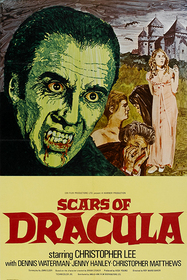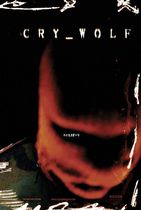Our editor-in-chief Nate Yapp is proud to have contributed to the new book Hidden Horror: A Celebration of 101 Underrated and Overlooked Fright Flicks, edited by Aaron Christensen. Another contributors include Anthony Timpone, B.J. Colangelo, Dave Alexander, Classic-Horror.com's own Robert C. Ring and John W. Bowen. Pick up a copy today from Amazon.com!
Scars of Dracula (1970)
Anyone wondering why Hammer Films felt the need to transplant Count Dracula to Swingin’ London in Dracula AD 1972 need look no further than Scars of Dracula (1970). This tepid continuation of the studio’s Dracula series proves, with little room for argument, that Hammer’s ability to deal with the vampire in his native Gothic setting had long ago dwindled to nothing. All devoted fans get for their troubles is a rehash of old ideas, a terribly insufficient plot, and a bad mishandling of Dracula as a character.
Scars of Dracula has one of those plots where many events occur, but none hold a particular importance over others. I am either forced to describe every little thing that happens, thus elongating my synopsis to levels that the word “boredom” wasn’t quite meant to cover, or explain nothing at all. Despite this handicap, I will attempt to succinctly sum up the film in just one sentence: Count Dracula (Christopher Lee) has guests at his castle and tries to eat them.
I will admit that it’s a bit more involved than that; the problem is that it’s not more involving. Much of Anthony Hind's screenplay is lifted from Psycho, of all places. A man on the run from the law (Christopher Matthews) disappears after a stop at Castle Dracula. His brother, with girlfriend in tow, investigates. Mashed into all of this are the now-tired gothic horror trappings of scared villagers, the vampire seductress, and the craven minion – all relics of previous Dracula films that had already been used and laboriously reused by this point in the series.
Occasionally the frivolity descends into nonsense. For instance, at the beginning of the film, the villagers storm Castle Dracula, pushing their way past Dracula’s manservant, Klove (Patrick Troughton) in order to burn down the stronghold of evil. We get a rather unimpressive shot of a model castle being consumed by enormous flames. Later, when we visit the castle, everything seems quite reasonable. The walls are adorned with blood-red tapestries of the type that would probably be incinerated in a major conflagration. Nothing is dilapidated, charred, or even mildly scorched. Still, Dracula feels the need to apologize to his guests at every turn for the wretched state of his home, like a mother who just finished eight hours of cleaning but still fusses that there might still be dust somewhere in the house.
Something new that Hinds and director Roy Ward Baker do add to the standard Hammer formula is a streak of sadistic violence. Dracula here is no mere vampire, seeking blood as a means of sustaining his life. Now he’s a cruel, Sadean taskmaster who stabs a female vampire to death (how does that even work?) and whips Klove with a white-hot sword. He impales one victim on a metal hook and sends legions of bats to massacre an entire church of women and children. In each of these instances, the camera pauses almost lovingly on the carnage, soaking in as much of each bloody, oozing wound as possible within the limits of what the British Board of Film Censors would allow. I can only assume that this was a cynical attempt on Hammer’s part to “give the audience what it wants,” as it were. However, positioning Dracula, typically a representation of the sexuality and sensuality of horror, as a sneering avatar of meaningless violence doesn’t so much meet a demand as it inspires incredulity.
Scars of Dracula is the first Gothic horror film that Baker directed and his newness to the genre is apparent, as he doesn’t seem to have a blessed clue what to do. From a production design aspect, the film is lazy – everything in Castle Dracula that can accommodate blood red hues, does, from bedding to seat cushions, from wall hangings to libations. While art director Scott MacGregor is partially responsible for the crimson overkill, Baker proudly takes his share of the “credit” in the DVD commentary. I have a hard time swallowing that Dracula, having lived for hundreds of years and seduced thousands of women, never heard of such a thing as a complementary color.
Worse, Baker has no idea how to light for mood. Inside Castle Dracula, there’s hardly a shadow – everything is bright and overlit. The plaque on Dracula’s coffin has a shiny gleam to it, which is curious when you realize that Dracula’s room can’t be accessed by anyone but the Count – does he polish daily? The lighting also overwhelms the pale makeup that Lee wears, washing out his face and drawing attention to the pink of his lips rather than his commanding eyes or imposing expression. It’s an effect that is unsettling for all the wrong reasons.
If I had to point out a bright spot in all of this – beyond the ineffable performance of Mr. Lee (whose excellence is covered in more places on this site than I can mention) – it would be Patrick Troughton’s performance as Klove. As a long-time Doctor Who fan, I am quite aware of Troughton’s comedic skills and his ability to essay heroic characters. His turn in Scars of Dracula is something different, though. Here he plays a tormented soul, torn between utter fealty to his master, Dracula, and love for the hero’s girlfriend – love he knows will never be reciprocated. Troughton always keeps his feet firmly planted in both of the character’s motivations, so that we never know if he is helping or hurting the protagonists on their quest to destroy Dracula. This ambivalence elevates his performance well above the wretched material in which it is set. If there were awards for great acting in terrible films, Troughton should’ve at least garnered a nomination.
Despite Troughton and Lee, Scars of Dracula is a rushed product, a piece of marketing made to suck the money from unsuspecting wallets. Hammer still had some good films up their sleeve, but the days of Dracula’s relevance had quite clearly come to an end when the camera began rolling on this dud. You may not be able to keep a good vampire down, but it might’ve been best for all involved if they had at least tried.









wow, interesting how views
wow, interesting how views can differ.....of the 5 hammer dracula movies set in old times, Scars is my favorite, it outshines the others, especially the first one (i love these christopher lee dracula movies, but the first one was such a poor adaption of the book, i think hammer did better with their own stories instead of trying to adapt).....dracula is in the background in ALL the hammer movies, almost not a "star" at all, but even though he gets to be on screen very little, you FEEL his presence on the edges of everything....so the differences between these movies often comes down to how is the story going that drac is about to interfere with? Scars has such a good story going on with the two brothers and the sweet quaint love story of the one brother simon with sarah.....and the lady at the inn is just great, what 70s cutesy innenuendo meeting of her and paul....and michael ripper is always so good in the supportive roles...
scars does not get the "my fav" slot of these 7 movies, however, only gets "my fav" of the first 5 set in old times.....the top movie is AD 1972, yes, it's cheesy and very dated, but what a fun hour and half spent in swinging london, what groovy music, both the stoneground and the cheesy 70s soundtrack jazz music....unfortunately, the next and last christopher lee movie of this series was Satanic Rites of Dracula....the worst of the 7 Lee made with hammer, the worst vampire movie ever made...maybe....well, it does have a really nice opening scene with a lot of nudity...other than that, it's not worth wasting time on